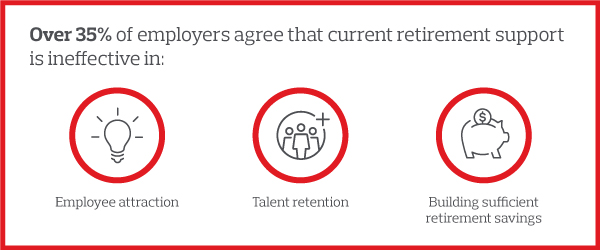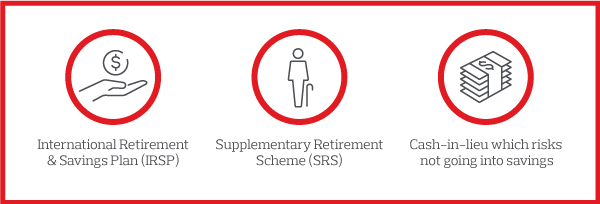SINGAPORE: 2021 Trends in Retirement & Financial Wellbeing
The Aon Singapore 2021 Trends in Retirement & Financial Wellbeing study is designed to help employers identify opportunities in their retirement and financial wellbeing program offerings to ultimately improve employee engagement, resilience and overall wellbeing. The most effective approaches for these programs are aimed at changing individual behaviours towards money and savings and providing accessible programmes and vehicles to deliver sustainable change. Organisations in Singapore across all sectors with employee populations ranging from five to over 4,000 took part in our study.
Read on for our key findings:
Retirement
Only Singapore citizens and permanent residents are eligible for Central Provident Fund (CPF) benefits, and almost half the population in Singapore are foreigners who do not receive this benefit. Furthermore, contributions to the CPF are based on a capped salary.
This creates a gap in retirement adequacy for foreigners and those earning above the salary cap, and results in unequal retirement benefit across the workforce.
Retirement support is lacking:

Over 30% are prioritising reviewing their supplementary arrangements over the next 1-2 years
22% Provide top up contributions for CPF eligible employees
50% Offer retirement benefits for non-CPF eligible employees
Top 3 supplementary retirement vehicles for non-CPF eligible employees:

Investment choices are set up to fail:
A robust default strategy can deliver better outcomes for members over the long-term.
< 30% provide choice for members
< 15% have a default fund option
A well-balanced highly rated self-select fund range allows members to express their personal choices, from Responsible Investing to active or passive management.
Financial Wellbeing
There is an increasing awareness of the impact of unmanaged stress and money worries on employee productivity, absence, engagement and resulting impact on business performance.
This is leading to a willingness by employers to take action and an increase in programs addressing financial wellbeing resilience of employees.
An impactful financial wellbeing strategy should be designed to deliver and measure sustainable behavioural change to help employees adopt healthy financial habits and instil financial resilience.
Aon defines financial wellbeing as “A person’s ability to confidently manage financial life today, while preparing for the future and anything unexpected along the way.”
Financial wellbeing is viewed as a key benefit differentiator:

Of the four Wellbeing pillars, the Financial pillar is ranked the highest with close to 40% of organisations believing it’s the most important to implement followed by a 20% tie between Emotional Wellbeing and Mental Wellbeing.
Prevalence of financial wellbeing:

Top 3 financial education offerings considered most effective:

Close to 70% of organisations are likely to offer financial education via webinars or other media in the next 1-2 years.
Call to action for Singapore employers - the three key opportunities are:
- Making financial wellbeing support a reality for employees in 2021 - develop and deliver an engaging financial wellbeing programme
- Providing access to a savings plan for all employees including non-Singaporeans with no access to CPF
- Helping employees navigate investment choices via an appropriate default fund and engaging communications
For more information, please click on the buttons below.


Looking for more?
Stay updated
Click here to contact Aon’s APAC Retirement & Investment team